
STEVEN J. ZALOGA, illustrated by JIM LAURIER
V-1 FLYING BOMB. 1942-52. HITLER'S INFAMOUS "DOODLEBUG"
On May l6th, 1944, Hitler issued an order to start the missile attack on London by mid-June. Hitler wanted a massive attack with a 1,000 ground-launched missiles combined with aircraft-launched missiles, long-range coastal artillery, and bomber attacks. The codeword Rumpelkammer ("Junk-room") would alert the participating units to prepare the attack and would be followed ten days later by the codeword Eisbär ("Polar Bear") initiating the attacks. By early June, FR155W had an inventory of 873 missiles. In response to the D-Day invasion, Field Marshal von Rundstedt's headquarters issued the codeword Rumpelkammer late on June 6th (D-Day) with plans to begin the attack on June 12th. The regimental staff warned that they would not be ready in time, especially after P-47 Thunderbolts hit a fuel convoy on June 8th destroying 270,000 liters of missile fuel. That same day, Allied fighter-bombers also severely damaged one of the trains bringing missiles to the launch sites. Due to the D-Day landings, the nine ski sites and 31 modified sites in Normandy were abandoned without firing any missiles in combat. Likewise, the 23 new launcher sites for two new battalions located west of the Seine were never used.

Once near the launch ramp, the tubular wing spar and wings were finally mounted to the fuselage. From the details of the warhead, this is a standard FM03A-1 of the type used in the campaign against London. (NARA)
The codeword Eisbär was issued on June 12th, and General Heinemann departed for the FR155W command post at Saleux, southwest of Amiens. A rail-yard near the command post was heavily bombed that night which knocked out all the land-lines to the launch sites and forced a delay of the first launches to 2300hrs. The launch batteries reported that 63 of the 72 launch sites were ready to fire but, of the first salvo, only nine missiles actually left the launchers, and not one of these reached England. The second salvo, scheduled for 0330hrs, was only slightly more successful. Ten missiles were launched of which four immediately crashed in the vicinity of the launchers. Two more crashed into the Channel, and four reached England, one actually landing in London in Bethnal Green at 0418hrs. The Heinkel missile launchers were not yet ready and did not participate in the initial assault as planned. One of Churchill's advisors, Lord Cherwell, remarked that, "The mountain hath groaned and given forth a mouse!"
Heinemann ordered a cessation of launches and camouflaging of all launch sites until an inquiry could be made. It became quite clear that the launch troops, although very enthusiastic, had taken too many shortcuts to get the launch sites ready for the attack. The next attack, on the night of June 15th/16th, was far more successful. A total of 55 launchers fired 244 missiles, of which 45 crashed after launch, 144 reached the English coast, and 73 fell on London. Seven were shot down by fighters and 25 by anti-aircraft guns. On their own initiative, the 65th Corps also launched 53 missiles against the ports in the Portsmouth-Southampton area, hoping to disrupt Allied naval forces and shipping. When higher headquarters was informed of the port attacks, 65th Corps was reprimanded for violating Hitler's orders to concentrate on London.
Churchill held a meeting of the War Cabinet on the morning of June 16th and activated the "Diver" air defense plan. The British Anti-aircraft Command had developed the Diver plan in December 1943, but when the flying bombs failed to appear, the gun-belt shriveled due to the demand for anti-aircraft guns for Normandy. Instead, fighter aircraft were given a more prominent role. A balloon barrage was added on June 22nd, increasing from 480 balloons to 1,400 balloons. By moving guns from elsewhere in Britain, by June 28th there were 376 heavy guns and 576 light guns in the Diver belt protecting London against the "Doodlebugs", plus a further 560 light guns of the RAF Regiment and two US Army radar-directed AA battalions. Th Allies used many nicknames for the Fi-103. Besides official terms like Crossbow and Diver, popular names included Doodlebug, Buzz Bomb, and Hellhound, but V-1 became the most widely used.

A member of the launcher section makes final adjustments to the missile autopilot assembly prior to launch. (NARA)
After a brief survey, the RAF concluded thai its Tempest lighter was by far the best choice for daylight interception both due to its excellent speed and the potent effect of its 20mm cannon. The pilots were aided by the fact that the V-1s often slowed down from their peak speed after about 15-20 minutes of flight due to the gradual disintegration of the shutters at the front of the pulse-jet. German radar plots in late June indicated that the V-1s were flying about 80km/hr (50mph) below their anticipated speed. Pilots soon realized that care had to be taken in firing on these small missiles from too close a range since a 20mm cannon round could detonate the V-1's one-ton warhead with unpleasant consequences for the fighter. Some of those destroyed by fighters were not actually shot down. In late June, pilots accidentally discovered that if they could fly alongside the V-1 they could tip it over by banking their aircraft. When upset in this fashion, the V-1 gyroscopes could not cope with the sudden change and the missile plummeted to the ground. The top V-1 ace of the war was Squadron Leader Joseph Berry flying a Tempest with No. 501 Squadron with 60 victories. Of the aircraft types, the Tempest was the high scorer with 663 claims, followed by Mosquito night fighters with 486. The two top-scoring squadrons were both Tempest units, No. 3 Squadron (257 kills) and No. 486 Squadron (221).
By mid-July 1944, FR155W had fired about 4,000 missiles. Only about 3,000 actually reached the air defense corridor to London and 1,192 were knocked down, 924 by fighters, 261 by guns, and 55 by balloons. Hitler was exhilarated by press accounts of the terror the missile was causing in London and ordered the Luftwaffe to expand the effort. On July 12th, surveys began for additional launch sites, and on July 17th, the new FR255W was formed in order to create a V-1 missile brigade.
The V-1 attacks caused panic in London and there was an unofficial exodus from the city that summer. In addition, under a government plan, over 360,000 women, children and infirm were evacuated. What was especially frightening about the Doodlebugs was their eerie sound during (he final approach. The pulse-jet engine was extremely noisy and could be heard from a great distance, but after the auto-log locked the tail controls into a dive, the engine usually shut off. The sputtering roar of the pulse-jet abruptly ended, followed by a sinister silence as the Doodlebug descended. This was not caused by the exhaustion of fuel as was widely believed, nor was the engine shut off intentionally. The Germans expected that the Fi-103 would go into a powered dive, not realizing that the engine vanes were so weakened by the hammering of the pulse-jet during the flight that the dive usually caused a massive shutter failure which ended engine combustion.
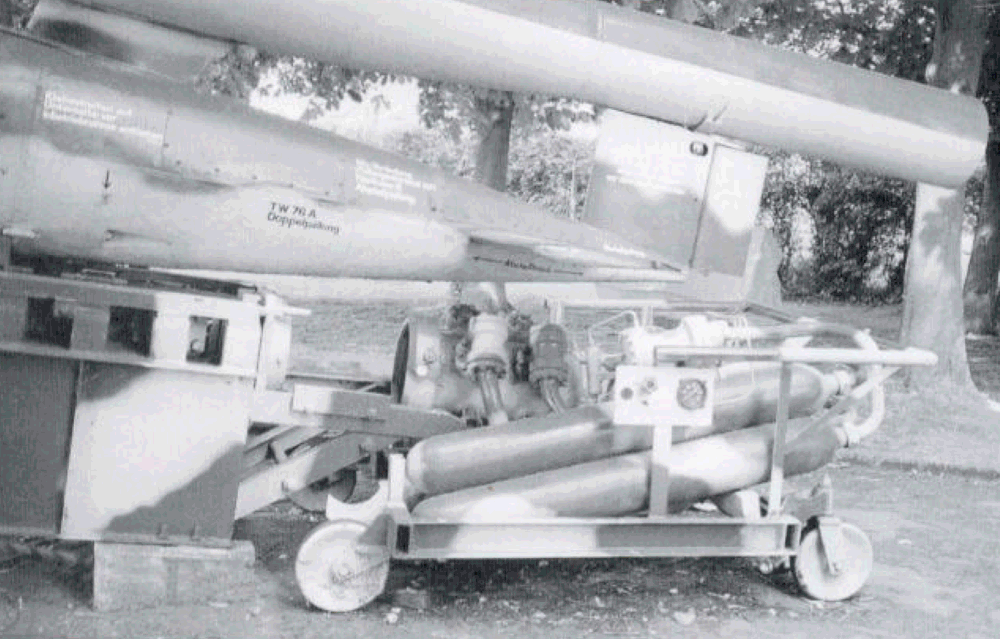
The ramp catapult was powered by a gas generator mounted on the Dampferzeuger trolley which was wheeled into place behind the ramp. These were nicknamed the Kinderwagen and were built by the Mansfeld GmbH in Leipzig beginning in September 1943. Each firing site had two of these. (T. Desautels)
Churchill demanded that more action be taken to silence the missile batteries. Air attacks against the modified sites were intensified in early June 1944 but proved difficult as they were easy to camouflage and quick to move. More lucrative targets were the large missile storage centers, or Feldmulag (field munition depots), located in old quarries north of Paris. The Luftwaffe had planned to create 17 of these which could have sheltered about a thousand missiles each, but only three were operational: Leopold No. 1106 near St. Leu d'Esserent, Nordpol No. 1111 near Nucourt, and Richard No. 1116 near Rilly la Montague. The two first sites were hit by the US Eighth Air Force in late June, but the thick caves at Leopold required another attack by the RAF's No. 5 Group with massive Tallboy bombs, which collapsed the tunnels during bombing on July 4th/5th. There was a decline in V-1 attacks for a few weeks until new supplies could be brought forward.
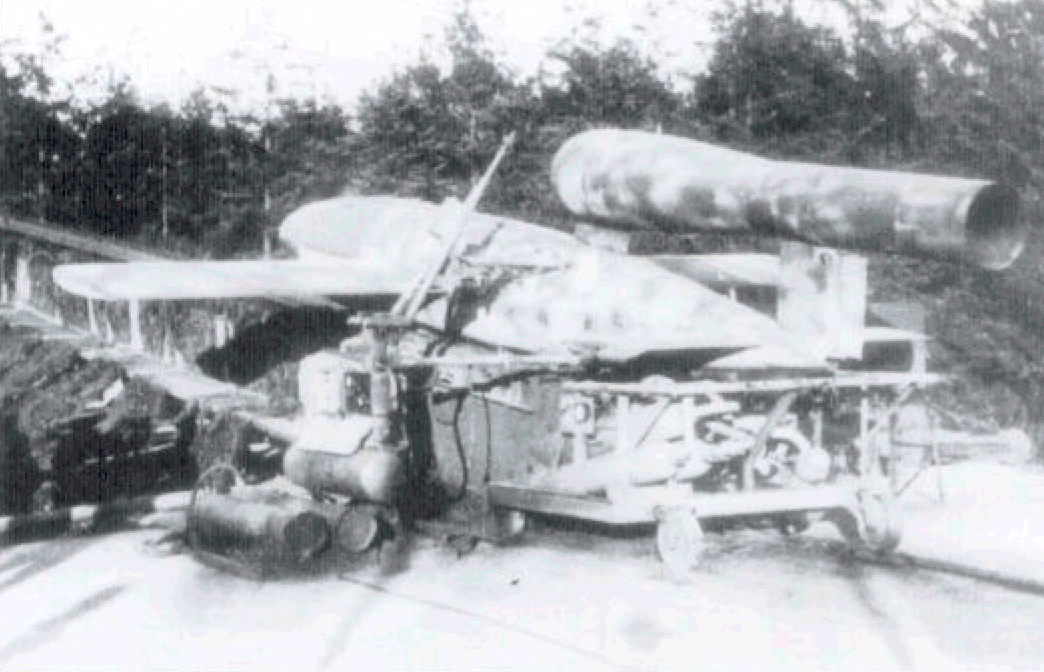
An FM03A-1 is loaded on the ramp with the Dampferzeuger catapult trolley in place and ready for launch. The Anlassgerät starter device immediately behind the wing provided the missile with pressurized air and electrical power prior to launch. (NARA)
Even though one third of the missiles were being shot down by the London defense in early July, this was still not good enough. A significant problem for the air defense was achieving the proper mixture of guns and aircraft since, when fighters were present, the guns had to remain silent. To improve the air defense system, the anti-aircraft and lighter commands agreed to reorganize and introduce improved equipment. The anti-aircraft guns would be shifted to the coast where the new American SCR-584 gun-laying radars would have an unobstructed view of the missiles as they approached. The move took place on July 16th-17th, 1944, and required re-laying almost 2,000 miles of telephone cable and moving thousands of tons of weapons, ammunition, and equipment. The US Army also added a further improvement with the first combat use of its top-secret "variable-time" (VT) fuze which proved to be more than five times as effective as conventional fuzes. The VT fuze was a miniaturized radar proximity fuze that detonated the projectile when it approached close to the target (standard anti-aircraft fuzes had to be set before firing according to the predicted height of the target and were therefore less accurate). The US Army had been reluctant to use the new design, fearing that, if any fell into enemy hands, a German copy could wreak havoc among the Allied heavy bombers over the Reich. The improvement was dramatic. During the third week of July, the guns accounted for half of all flying bombs reaching the London area and continued to improve, reaching 83 percent by the end of August. The redesigned defenses proved much more effective, downing about 40 percent of the Doodlebugs before the move, and nearly 60 percent after the move.
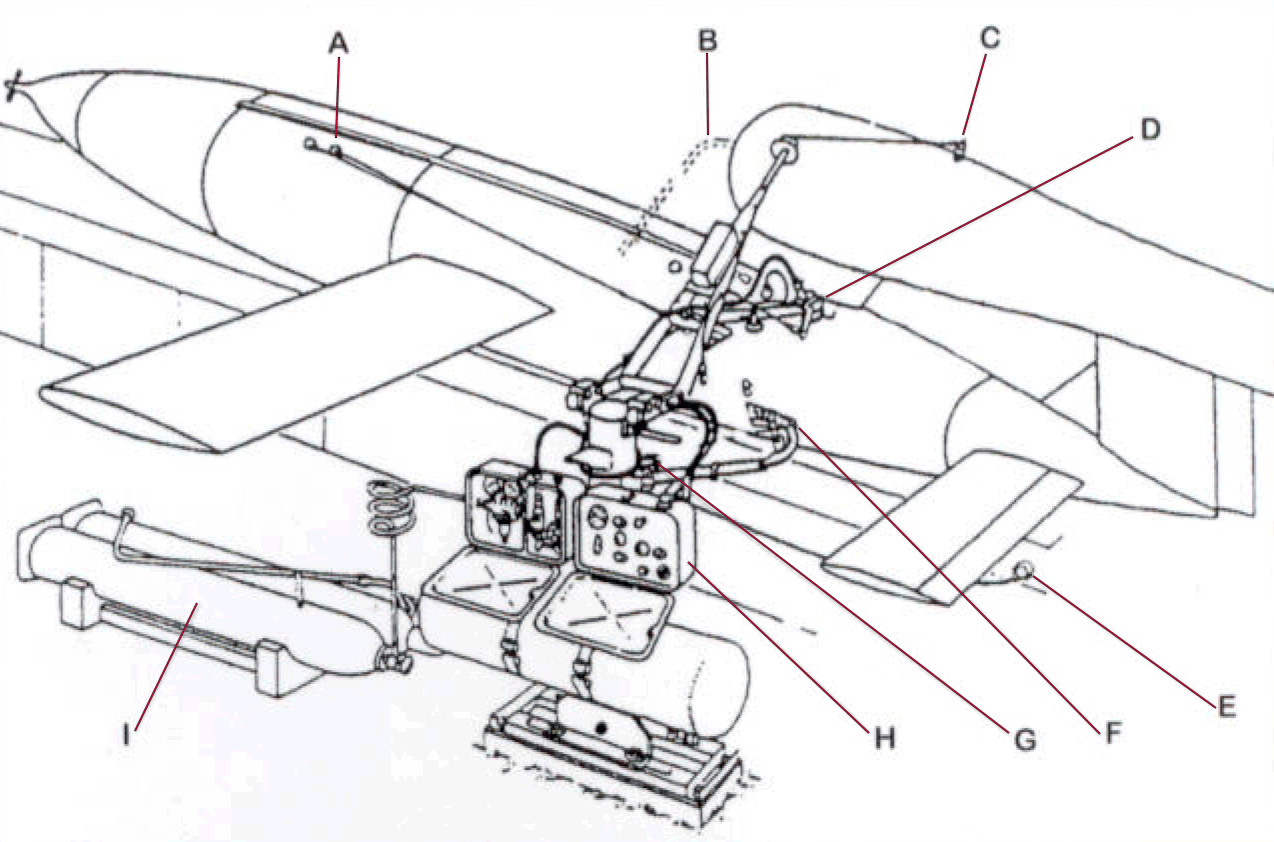
This illustration from the FZG-76 technical manual shows the manner in which the Anlassgerät starter device was attached to the missile. This included the electrical line to the fuzes (A); compressed air line to the engine intake (B); electrical line to the engine spark plug (C); electrical connections to the autopilot (D); connection to the launch ramp (E); air pressure connection (F); attachment controls (G); control panels (H); and air pressure cylinders (I).
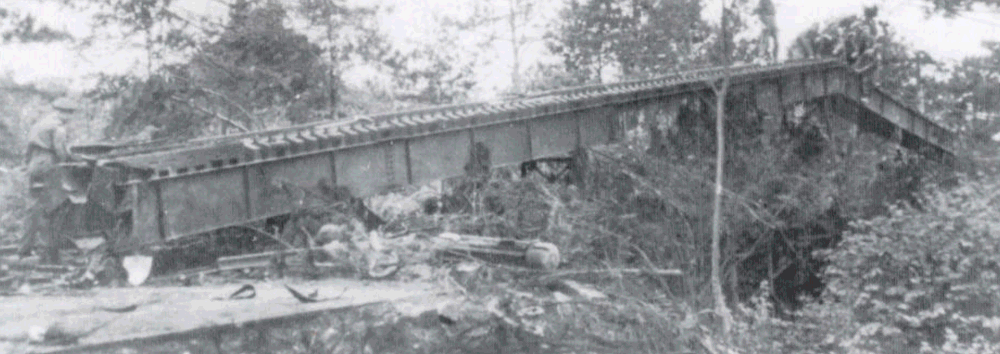
A Walter Schlitzrohrschleuder WR 2.3 catapult abandoned in northern France in late August 1944. The front end of the ramp has collapsed, but this photo gives an impression of its great length. The ramp was constructed of six to eight modular sections with a length of 36-48m (118-158ft). (NARA)
The peak V-1 assault occurred on August 3rd when 316 missiles were launched, of which about 220 reached London. But the number launched subsequently began to fall due to the growing problems of supplying the sites, and the gradual loss of the launching areas. After having started with 72 launch sites on June 12th, the regiment suffered gradual attrition due to Allied air attacks, averaging 34 operational launchers per day during the course of the summer campaign. By mid-August, Allied forces were across the Seine river and threatening the launch area. General Heinemann ordered all surplus equipment moved towards Antwerp and bases in the Netherlands. On August 9th, IVAbteilung was ordered to pull out, and the neighboring III Abteilung the following day. The corps headquarters was moved from France to Waterloo in Belgium on August 18th-19th. By the end of August, only 1 Abteilung continued to launch missiles, firing its last from France at 0400hrs on September 1st.
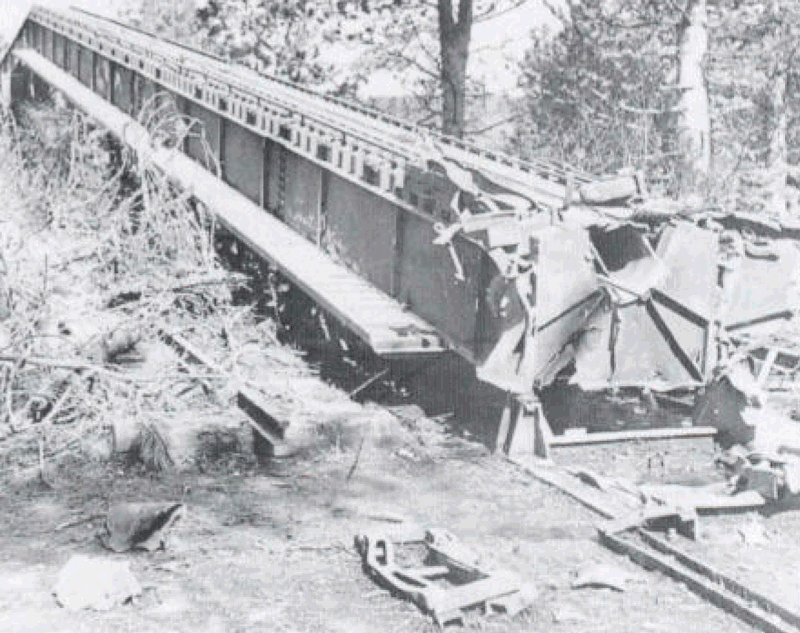
A view of a Walter WR 2.3 launch ramp abandoned near Amiens in August 1944. The missile was placed on a Spazierstock frame, one of which is evident in the foreground. A piston was placed in the circular tube inside the ramp which clipped to the missile. (NARA)
During this first phase of the missile campaign, a total of 8,617 V-1 missiles was launched by FR155W, of which 1,052 crashed immediately after take-off and 5,913 made ii to Britain; 3,852 were knocked down by air defenses (1,651 by guns). So only about 2,300 missiles actually impacted in the target area, about a quarter of those launched.
The air-launched missile campaign
Although there had been plans to begin launching FZ076 missiles from the He-111 bombers of III/KG3 at the start of the Operation Eisbär in June, delays in equipping and training the squadron delayed its start. On July 9th, the squadron began attacks on London from Dutch airbuses. By July 21st, a total of 51 FZG-76 missiles had been launched. On the evening of September 2nd, 23 were launched against Paris with little effect. By September 5th, 1944, when the first wave of attacks ended, III/KG.3 had launched 300 missiles against London, 90 against Southampton and 20 against Gloucester at a cost of two He-111 bombers.
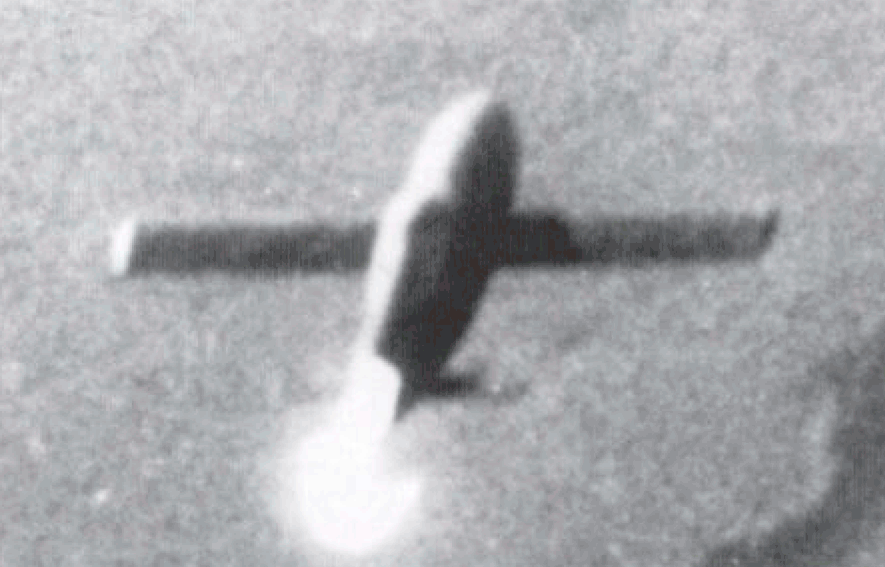
A V-1 on its way to London photographed during the summer 1944 attacks. (NARA)
The air-launched missiles were particularly inaccurate; none hit Gloucester and British authorities thought the shots against Southampton had been aimed at Portsmouth. About half the air-launched missiles fell within a circle 50 miles around the target, which was about three times worse than the ground-launched versions. The rapid Allied advance into Belgium and intense Allied air activity over the Netherlands forced the squadron to withdraw into Germany. Reorganization and expansion followed, with III/KG3 becoming I/KG53 and two more squadrons were allotted to the mission in October. When ready, the three wings deployed again to Dutch airbases.
At first, the British air defenses did not realize that aerial missile launches were being conducted but radar began tracking the missiles coming in from the North Sea, and starting on September 16th the gun belt was extended towards Great Yarmouth to deal with the threat. The air campaign proved costly and difficult for the Luftwaffe. For example, on a typical night assault on the evening of September 16th, of 15 bombers setting off, only nine released their missiles successfully; three of these were shot down by ships, two more by antiaircraft and only two reached the London area. Launch failures averaged a quarter to a half of all missiles dropped.
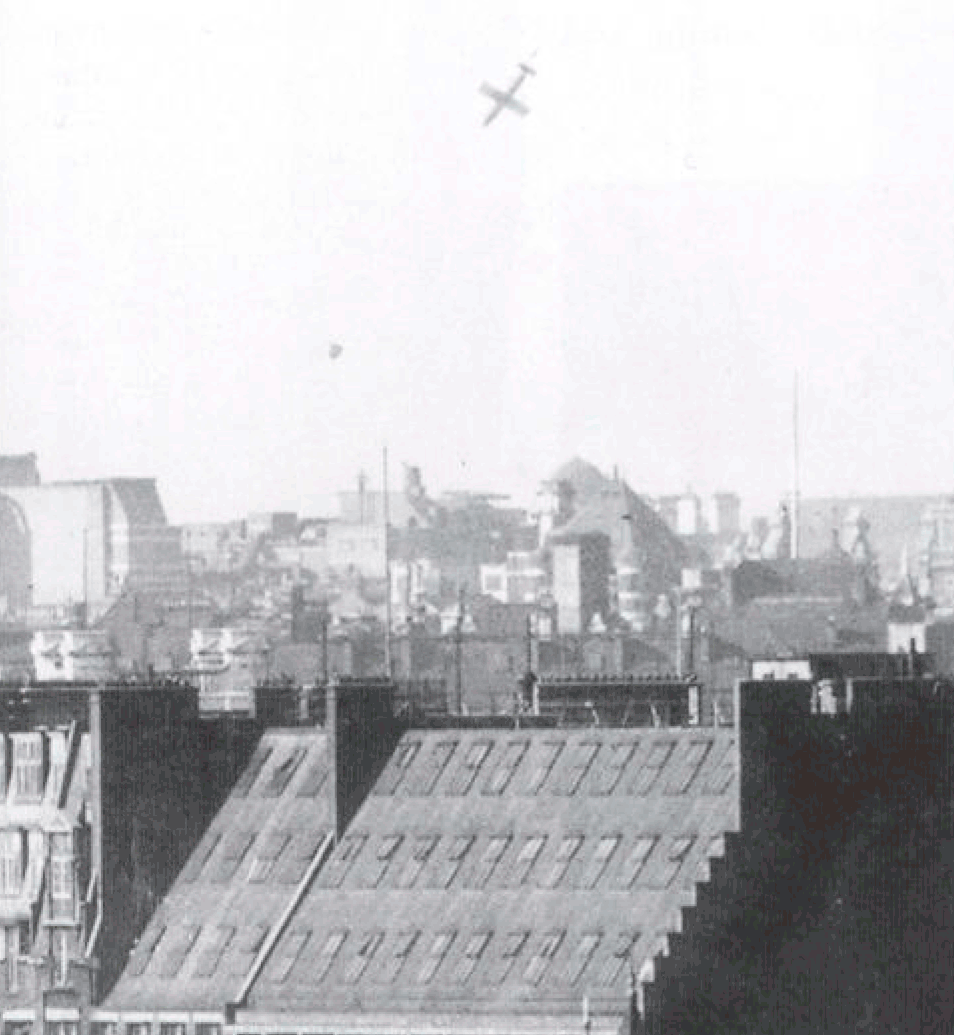
A V-1 falls towards Piccadilly on June 22nd, 1944, during the opening phase of the missile attacks on London. (NARA)
When the land-launched V-1 campaign ended on September 1st, 1944, the air-launched missiles became more conspicuous and the RAF began a more vigorous effort to stamp out the threat. On September 24th, No. 25 Squadron began deploying Mosquito night fighters over the North Sea to look for the intruders. The Heinkels were caught unawares and on the night of September 25th, four bombers with their missiles were shot down, and two more were lost on September 29th. The weight and drag of the missile reduced the cruise speed of the He-111H-22 to 270km/hr (170mph) and, even though the bombers were fitted with Liechtenstein radar-warning receivers, if a Mosquito spotted one, the Heinkel stood very little chance of survival. Three more bombers were caught by Mosquitoes in October.
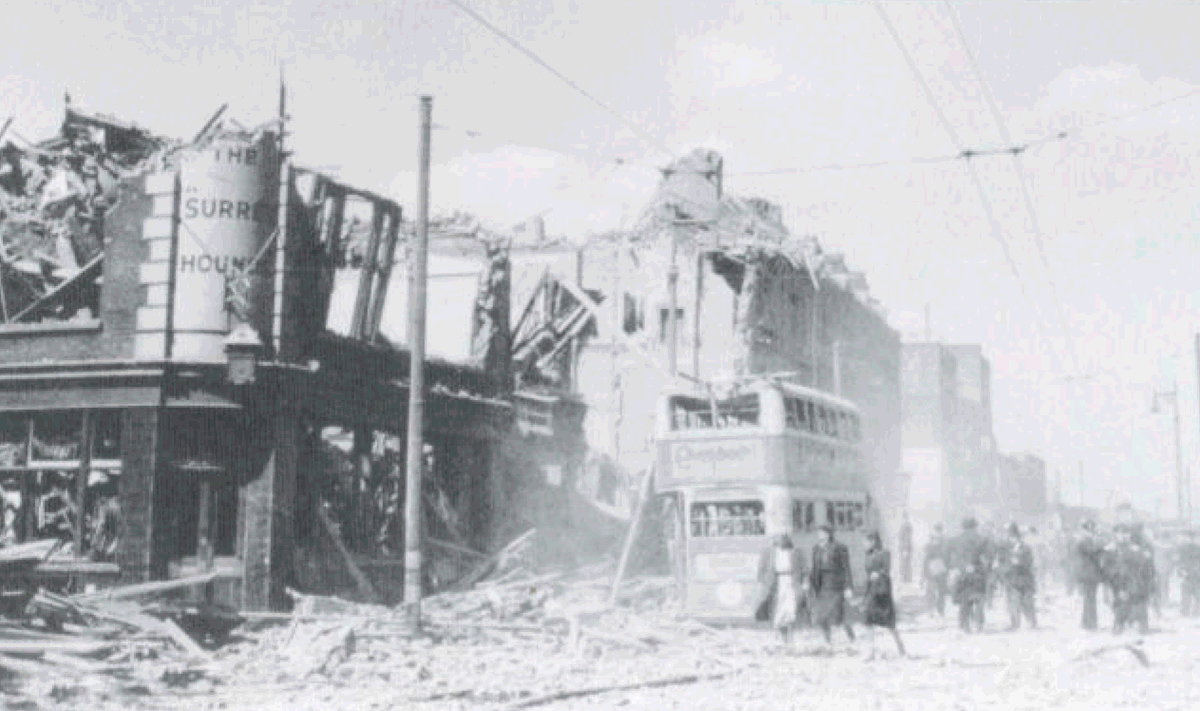
The V-1 was designed with very sensitive fuzes to detonate on contact. This shows the devastating results of an impact at St. John's Hill, Battersea on June 17th, 1944, during the first week of the attacks. (MHI)
The campaign continued through the fall, with the force slowly growing. On October 20th, KG53 had an operational strength of 77 bombers and a further 24 under repair. In November 1944, improved navigational aids were introduced including the Schwan ("Swan") FM transmitter and three Zyklof) ("Cyclops") beacons on the Dutch coast. By early November, a total of 1,287 Fi-103 missiles had been launched during the air attacks. In December, fuel shortages reduced the sortie rate to only 20 per day and operations had to be halted for two weeks after a dozen bombers were lost in two operations when missiles detonated prematurely. On Christmas Eve, KG53 staged Operation Martha, its first and only large scale attack against Manchester by 50 bombers. Only 30 Fi-103 missiles reached the English coast; half of these got to within 15 miles of the center of the city but only one actually landed within the city. By this time, KG53 had reached its peak operational strength of 117 bombers plus 85 more under repair. The last aerial launch was conducted on the night of January 14th, 1945, and nine days later the flights came to a halt due to the lack of fuel. By the end of the campaign, 1,776 missiles had been launched of which Allied radars identified 1,012. Of these, 404 were shot down including 320 by anti-aircraft, 11 by the Royal Navy, and 73 by the RAF. Only 388 impacted in England of which only 66 reached London. A total of 77 He-111 bombers was lost during the attacks, at least 16 to Mosquitoes, and the rest to weather and accidents. In other words, less than four percent of the missiles reached their target and more than one bomber was lost for every missile reaching London, a woefully ineffective record.

A fairly intact specimen of a V-1 found near a Ninth Air Force airfield in northern France. Judging from the warhead, it is an FI-103A-1, the standard type used in the campaign against London. It has had its two fuzes removed. (NARA)
We have much more interesting information on this site.
Click MENU to check it out!
∎ cartalana.com© 2009-2025 ∎ mailto: cartalana@cartalana.com